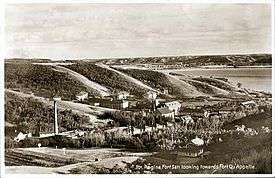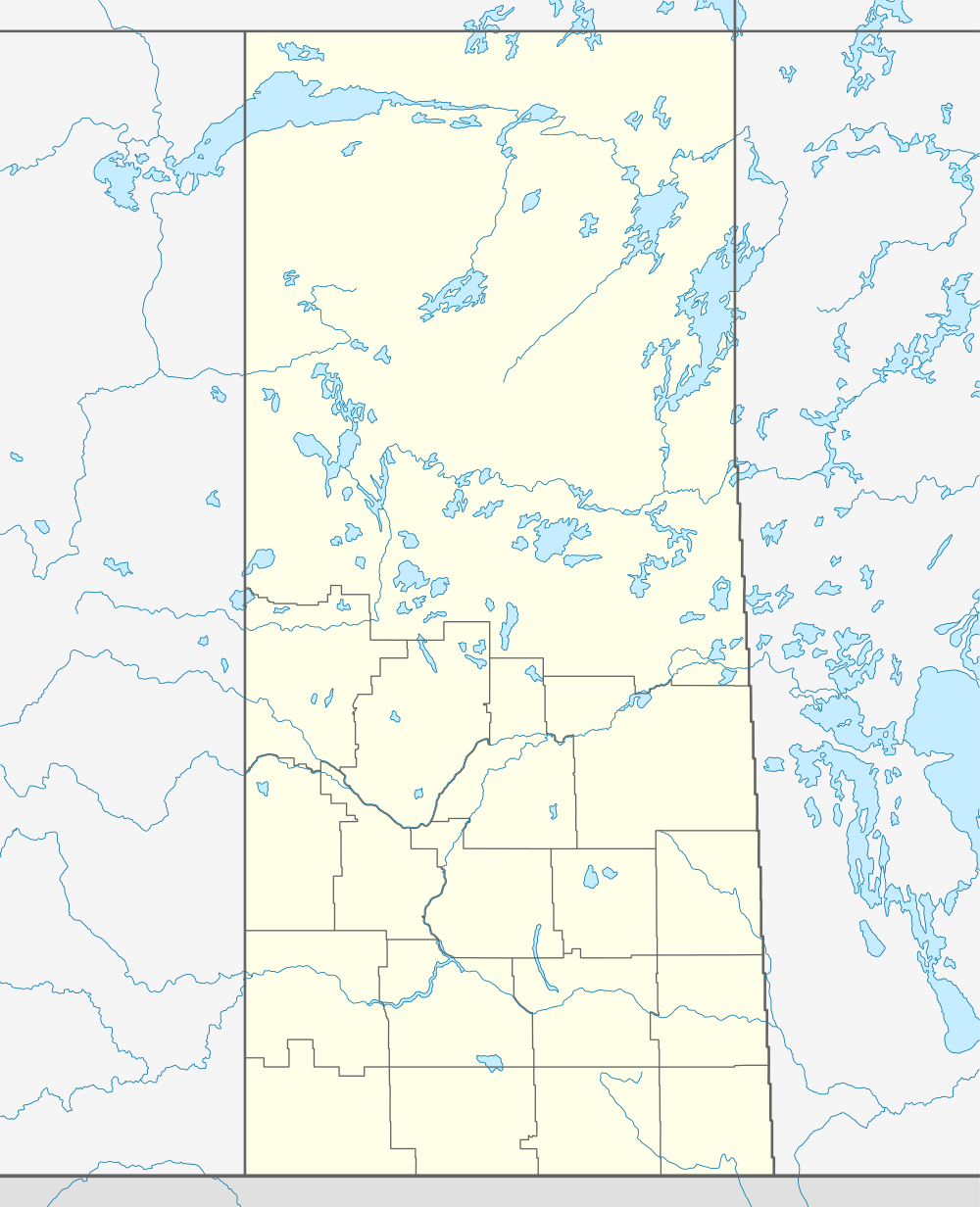Fort San, Saskatchewan
| Fort San, Saskatchewan | |
|---|---|
| Resort Village | |
 | |
| Fort San looking towards Fort Qu'Appelle, 1920s | |
 Fort San, Saskatchewan | |
| Coordinates: 50°48′09″N 103°49′37″W / 50.80250°N 103.82694°WCoordinates: 50°48′09″N 103°49′37″W / 50.80250°N 103.82694°W | |
| Country | Canada |
| Province | Saskatchewan |
| Region | Central |
| Census division | 9 |
| Rural Municipality | North Qu'Appelle |
| Established | 1917 |
| Government | |
| • Governing body | Fort San Village Council |
| • Mayor | Jim Harding |
| • Administrator | Beverly Van der Breggen |
| Area | |
| • Total | 2.90 km2 (1.12 sq mi) |
| Population (2006) | |
| • Total | 215 |
| • Density | 74.2/km2 (192/sq mi) |
| Time zone | CST (UTC-6) |
| Postal code | S0K 4P0 |
| Area code(s) | 306 |
| Highways | Highway 56 |
| [1][2][3][4] | |
Fort San (Assiniboine: téhą wįcóyazą oʾáwąyage tíbi [5] ) is a former sanatorium and then summer arts camp, now a resort village, surrounded by the rural municipality of North Qu'Appelle No. 187, Saskatchewan, Canada. The village is located approximately 77 km northeast of Regina and 3 km west of Fort Qu'Appelle. With the closure of the sanatorium the area was repurposed originally as a venue to house the Saskatchewan Summer School of the Arts and later as a resort village housing the Echo Valley Conference Centre.
History


Fort San was opened in 1917 during a time when tuberculosis infections were increasing, and was built to house 358 patients. It was a self-sufficient institution with vegetable gardens, livestock, a power house, and an extensive library for patients provided by World War I veterans. Fort San was a medical purgatory where hundreds died and thousands suffered. Isolation, loneliness and pain were a way of life for its citizens; some of whom lost years of their lives, if not life itself. Fort San is considered one of Saskatchewan’s most haunted locations.[6]
Saskatchewan Summer School of the Arts
After tuberculosis became less of a threat in the early 1960s, the sanatorium building's purpose was changed to house the Saskatchewan Summer School of the Arts in 1967. For thirty years, thousands of young people received summer tuition in dance, music, visual art, writing and theatre. Through the 1970s the facilities were expanded and improved to support the school over its 30 years. "Over 1,200 children and adults attended the seven-week program at the School during the summer of 1968."[7] The school was closed in 1991 due to lack of funding.[8] The Sage Hill Writing Experience is one of the spin-offs of the school that continued to operate using a variety of venues around the province.[9] Existing facilities were expanded and improved throughout the 1970s as the popularity of the School increased.
HMCS Qu'Appelle Cadet Summer Training Centre
Fort San was run as a Royal Canadian Sea Cadet Camp named HMCS Qu'Appelle Cadet Summer Training Centre during the summers of the nineties to 2004. The programs offered were:
- Music
- Sailing
- General Training
One of the operating rooms was even converted to a 4 bunk barrack room and the cadets taking sailing or general training generally slept directly over the morgue.
It is an urban legend that Fort San is haunted by patients who died at there in its early years. Several authors have documented different accounts of strange occurrences which transpired in the time since it was retired as a sanatorium.[10]
Echo Valley Conference Centre
The Echo Valley Conference Centre, a provincial government run conference facility is operated out of the historic building on the site. The conference centre makes use of Arts and Craft/Tudor Revival style building built from 1912 to 1922 for use by the sanitarium.[11] On September 30, 2004 a decision was made by the Saskatchewan Property Management Corporation to shutdown the Centre and offer it for sale.[12]
Demographics
| |||||||||||||||||||
See also
Notes
- ↑ National Archives, Archivia Net. "Post Offices and Postmasters".
- ↑ Government of Saskatchewan, MRD Home. "Municipal Directory System".
- ↑ Canadian Textiles Institute. (2005). "CTI Determine your provincial constituency".
- ↑ Commissioner of Canada Elections, Chief Electoral Officer of Canada (2005). "Elections Canada On-line".
- ↑ "AISRI Dictionary Database Search--prototype version. Assiniboine.". Retrieved 2012-07-07.
- ↑ An History of the Fight Against Tuberculosis in Canada
- ↑ "SASKATCHEWAN SUMMER SCHOOL OF THE ARTS (Encyclopedia of Saskatchewan)". University of Regina. Retrieved 2011-03-06.
- ↑ Qu'Appelle - Stories From the San
- ↑ "HOW SAGE HILL HAPPENED". Sage Hill Writing Experience. Retrieved 2011-03-06.
- ↑ Jo-Anne Christensen. Ghost Stories of Saskatchewan. Hounslow Press, 1995. ISBN 978-0-88882-177-5.
- ↑ Canada's Historic Places - A Federal Provincial and Territorial Collaboration. "Echo Valley Conference Centre (Fort San) Fort San, Saskatchewan, S0G, Canada". Retrieved 2011-02-19.
- ↑ "Saskatchewan Property Management Corporation; page 12" (PDF). Saskatchewan Property Management Corporation. Retrieved 2011-03-06.
- ↑ "2011 Community Profiles". Canada 2011 Census. Statistics Canada. July 5, 2013. Retrieved 2012-08-11.
- ↑ "2006 Community Profiles". Canada 2006 Census. Statistics Canada. March 30, 2011. Retrieved 2011-03-06.
- ↑ "2001 Community Profiles". Canada 2001 Census. Statistics Canada. February 17, 2012. Retrieved 2011-03-06.
External links
- Municipal Affairs - Fort San
- Map of Fort San at Statcan
 |
Dysart | Lipton | Herzel |  |
| Pasqua Lake | |
Balcarres | ||
| ||||
| | ||||
| Edgeley | Fort Qu'Appelle | Lebret |
| ||||||||||||||||||||||